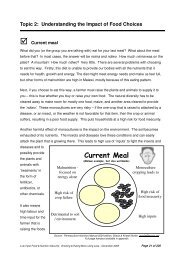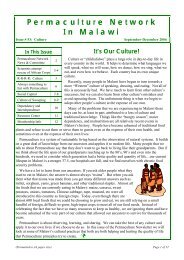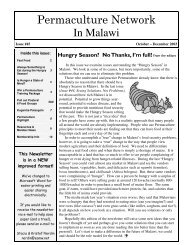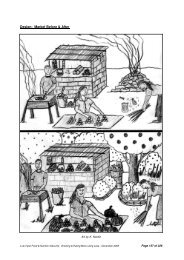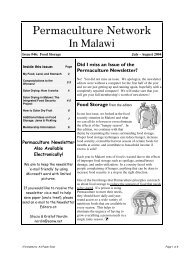Permaculture, Final Capstone Paper 5-26, Hope - Never Ending Food
Permaculture, Final Capstone Paper 5-26, Hope - Never Ending Food
Permaculture, Final Capstone Paper 5-26, Hope - Never Ending Food
Create successful ePaper yourself
Turn your PDF publications into a flip-book with our unique Google optimized e-Paper software.
a majority of Malawi’s farmers have not adopted the new high yielding technologies and farming<br />
systems. (MoA, 2005; Chirwa, 2007; Simtowe, 2006)<br />
Ephraim Chirwa’s study of adoption of fertilizer and hybrid seeds by smallholder maize<br />
farmers in southern Malawi found that adoption of productivity enhancing technologies,<br />
specifically fertilizer, was positively associated with higher levels of education, larger plot sizes,<br />
and higher non-farm incomes, and negatively associated with households headed by women and<br />
distance from input markets. The study also found that hybrid seed adoption is positively<br />
associated with market-based land tenure systems and fertile soils while it is negatively<br />
associated with age and distance from input markets. Chirwa’s study differs from earlier<br />
research (Green & Ng’ong’ola, 1993) which considers only fertilizer technology adoption, where<br />
Chirwa’s study highlights the joint-decision making process and interdependency of adopting<br />
fertilizer and hybrid seed technology.<br />
Similarly Simtowe (2007) explores the link between adoption of fertilizer and HYV seed<br />
through the lens of risk aversion. The study shows that risk aversion towards fertilizer is<br />
positively associated with low intensity of hybrid maize adoption. Simtowe stresses that even in<br />
instances where free inputs are provided, adoption rates remain low. In Simtowe’s study, factors<br />
such as age, household size, land size, and off farm income were found to be useful in explaining<br />
non-adoption of fertilizer.<br />
Research on adoption of sustainable agriculture techniques, such as Neill and Lee’s<br />
(2001) study of maize-mucuna system in Northern Honduras, found significant and positive<br />
associations with farm size and tenure security. Neill and Lee explain that, like Green<br />
Revolution technologies, possession of a minimum threshold farm size and therefore a longer–<br />
term planning horizon are critical for adoption (p. 809) of sustainable agriculture techniques.<br />
19



